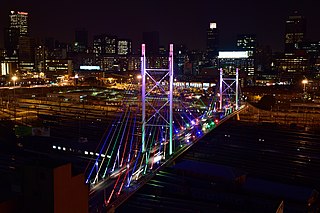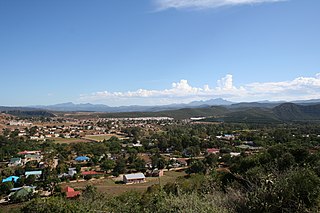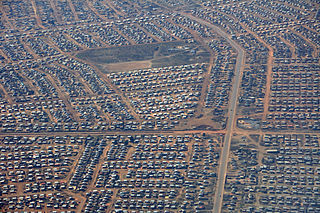
Soweto is a township of the City of Johannesburg Metropolitan Municipality in Gauteng, South Africa, bordering the city's mining belt in the south. Its name is an English syllabic abbreviation for South Western Townships. Formerly a separate municipality, it is now incorporated in the City of Johannesburg Metropolitan Municipality, and one of the suburbs of Johannesburg.

Johannesburg is the most populous city in South Africa with 4,803,262 people, and is classified as a megacity; it is one of the 100 largest urban areas in the world. It is the provincial capital and largest city of Gauteng, which is the wealthiest province in South Africa. Johannesburg is the seat of the Constitutional Court, the highest court in South Africa. Most of the major South African companies and banks have their head offices in Johannesburg. The city is located within the mineral-rich Witwatersrand hills, the epicentre of the international-scale mineral, gold and (specifically) diamond trade.

In South Africa, the terms township and location usually refers to an underdeveloped racially segregated urban area, from the late 19th century until the end of apartheid, were reserved for non-whites, namely Black Africans, Coloureds and Indians. Townships were usually built on the periphery of towns and cities. The term township also has a distinct legal meaning in South Africa's system of land title, which carries no racial connotations.

Midrand is a former municipality in central Gauteng, South Africa. Situated in-between Centurion and Sandton, Midrand now forms part of the City of Johannesburg Metropolitan Municipality.

Johannesburg is a large city in Gauteng Province of South Africa. It was established as a small village controlled by a Health Committee in 1886 with the discovery of an outcrop of a gold reef on the farm Langlaagte. The population of the city grew rapidly, becoming a municipality in 1898. In 1928 it became a city making Johannesburg the largest city in South Africa. In 2002 it joined ten other municipalities to form the City of Johannesburg Metropolitan Municipality. Today, it is a centre for learning and entertainment for all of South Africa. It is also the capital city of Gauteng.
Alexandra, informally abbreviated to Alex, is a township in the Gauteng province of South Africa. It forms part of the City of Johannesburg Metropolitan Municipality and is located next to the wealthy suburb of Sandton. Alexandra is bounded by Wynberg on the west, Marlboro and Kelvin on the north, Kew, Lombardy West and Lombardy East on the south. Alexandra is one of the poorest urban areas in the country. Alexandra is situated on the banks of the Jukskei River. In addition to its original, reasonably well-built houses, it also has a large number of informal dwellings or "shacks" called imikhukhu.

Orange Farm ("Farma") is a township located approximately 45 km (28 mi) from Johannesburg in the Gauteng Province of South Africa. It is the southernmost township of the City of Johannesburg Metropolitan Municipality. Its name, a misnomer given that oranges are grown in orchards instead of farms, has Dutch origins. It is one of the youngest townships in South Africa, with the original inhabitants, laid-off farm workers, taking up residency in 1988. Support for the population came slowly mostly from people who were tenants at the larger township of Soweto.
Ennerdale is a town in the City of Johannesburg Metropolitan Municipality in Gauteng, South Africa. Ennerdale was declared as a coloured group area under the apartheid regime.

The suburbs of Johannesburg are officially demarcated areas within the City of Johannesburg Metropolitan Municipality, South Africa. As in other Commonwealth countries, the term suburb refers to a "neighbourhood", although in South Africa most "suburbs" have legally recognised borders and often separate postal codes. The municipal functions for the area, such as municipal policing and social services, are still managed by the city government.

The City of Johannesburg Metropolitan Municipality is a metropolitan municipality that manages the local governance of Johannesburg, the largest city in South Africa. It is divided into several branches and departments in order to expedite services for the city. Zulu is the most spoken home language at 23.4% followed by English at 20.1%.

The Jukskei River is one of the largest rivers in Johannesburg, South Africa. It is the southernmost river in the Crocodile River basin.

Kliptown is a suburb of the formerly black township of Soweto in Gauteng, South Africa, located about 17 km south-west of Johannesburg. Kliptown is the oldest residential district of Soweto, and was first laid out in 1891 on land which formed part of Klipspruit farm. The farm was named after the klipspruit that runs nearby. From 1903 the area was home to informal settlements, and the area now contains a mixture of purpose-built housing and many shacks and other informal homes which form the Chris Hani and Dlamini settlements.

Thokoza, alternatively rendered Tokoza, is a township in Ekurhuleni, Gauteng. Thokoza is at the location of the now-defunct Palmietfontein Airport. It is situated south east of Alberton, adjacent to Katlehong. Thokoza was the first black township which was established in the South. During the early 1990s Thokoza was the middle of unrest between the supporters of the Inkatha Freedom Party (IFP) and the African National Congress (ANC).
Reconstruction and Development Programme (RDP) was a South African socio-economic policy framework implemented by the African National Congress (ANC) government of Nelson Mandela in 1994 after months of discussions, consultations and negotiations between the ANC, its Alliance partners the Congress of South African Trade Unions and the South African Communist Party, and "mass organisations in the wider civil society".
Water privatisation in South Africa is a contentious issue, given the history of denial of access to water and persisting poverty. Water privatisation has taken many different forms in South Africa. Since 1996 some municipalities decided to involve the private sector in water and sanitation service provision through short-term management contracts, long-term concessions and contracts for specific services such as wastewater treatment. Most municipalities continue to provide water and sanitation services through public utilities or directly themselves. Suez of France, through its subsidiary Water and Sanitation Services South Africa (WSSA), and Sembcorp of Singapore, through its subsidiary Silulumanzi, are international firms with contracts in South Africa. According to the managing director of Silulumanzi "the South African water market is still in its infancy and municipalities are unsure of how to engage the private sector."

Water supply and sanitation in South Africa is characterised by both achievements and challenges. After the end of Apartheid South Africa's newly elected government struggled with the then growing service and backlogs with respect to access to water supply and sanitation developed. The government thus made a strong commitment to high service standards and to high levels of investment subsidies to achieve those standards. Since then, the country has made some progress with regard to improving access to water supply: It reached universal access to an improved water source in urban areas, and in rural areas the share of those with access increased from 66% to 79% from 1990 to 2010.
Prior to 1994, immigrants from elsewhere faced discrimination and even violence in South Africa due to competition for scarce economic opportunities. After majority rule in 1994, contrary to expectations, the incidence of xenophobia increased. In 2008, at least 62 people were killed in the xenophobic uprising and attacks. In 2015, another nationwide spike in xenophobic attacks against immigrants in general prompted a number of foreign governments to begin repatriating their citizens. A Pew Research poll conducted in 2018 showed that 62% of South Africans expressed negative sentiment about foreign nationals living and working in South Africa, believing that immigrants are a burden on society by taking jobs and social benefits and that 61% of South Africans thought that immigrants were more responsible for crime than other groups. There is no factual evidence to substantiate the notion that immigrants are the main culprits of criminal activity in South Africa, even though the claim is incorrectly made in sometimes by politicians and public figures. Between 2010 and 2017 the number of foreigners living in South Africa increased from 2 million people to 4 million people. The proportion of South Africa's total population that is foreign born increased from 2.8% in 2005 to 7% in 2019, according to the United Nations International Organization for Migration, South Africa is the largest recipient of immigrants on the African continent.

The Hennops River is one of the larger rivers that drains Gauteng, South Africa. It has its source near Kempton Park, east of Johannesburg and meets the Crocodile River shortly before Hartbeespoort Dam. It is one of Gauteng's most polluted rivers.
South Africa has been dubbed "the protest capital of the world", with one of the highest rates of public protests in the world.
Fire is a serious hazard in shack settlements in South Africa. It has been argued that "On average in South Africa over the last five years there are ten shack fires a day with someone dying in a shack fire every other day." In 2011, 151 were reported to have been killed in shack fires in Cape Town. It was reported that in 2014, 2,090 people burned to death in the Gauteng province, "many of them in shack fires that sweep through informal settlements".















